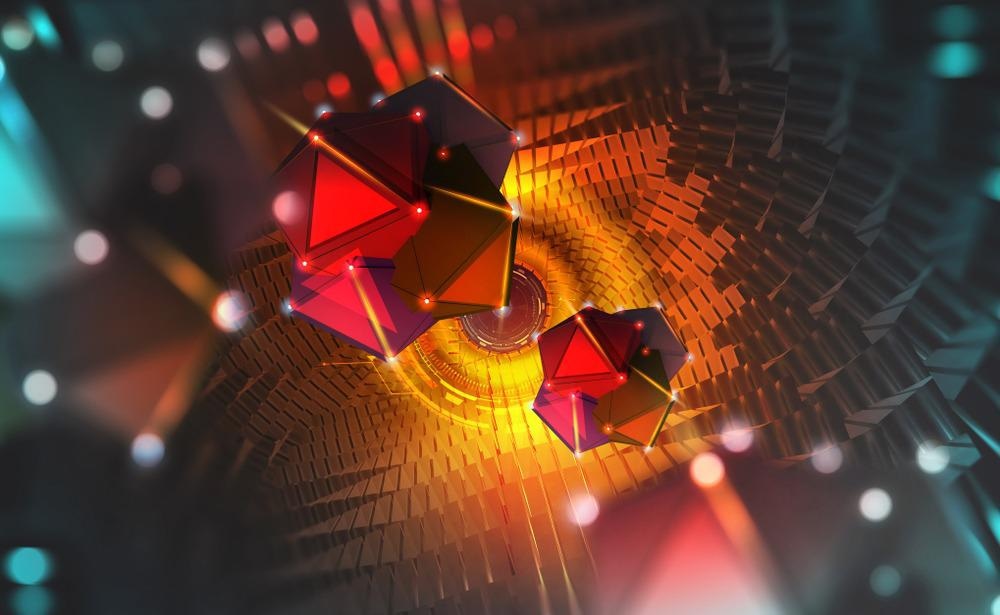Colloidal nanocrystals (CNs) are artificially grown inorganic particles stabilized by surfactants. Those smaller than 10 nm can transform their optical and electronic properties and exhibit a quantum confinement effect.

Image Credit:Yurchanka Siarhei/Shutterstock.com
The controlled synthesis of CNs is the primary step to exploiting its size-specific properties; the hot injection (HI) method is one of the most common methods. CNs are synthesized by degassing, injection, and quenching.
During the synthesis, ligands play a crucial role as their nonpolar property allow colloidal stability, control the addition and removal of atoms, and permit fine crystal growth. Different from single-component nanocrystals, heterostructures nanocrystals are synthesized for their carrier behaviors and optical and electrical properties.
Zinc blended CdSe nanoplatelets and anisotropic quantum rods synthesized from molecular beam epitaxy and HI are examples of shape-controlled CNs.
Understanding CNs' electronic properties can help to design sophisticated devices.
CNs are examined using X-ray photoemission spectroscopy, which is also used to identify CNs’ types and modify their energy spectrum.
Field-effect transistor (FET) configurations examine the properties of nanocrystal solids and give insights into the majority carriers’ nature and the carriers’ mobility in the nanocrystal solids.
Applications of Colloidal Nanocrystals
Due to their high photostability, color purity, and broad tunability, CNs have broad applications in light-emitting diodes (LEDs), biological imaging and tracking, solar cells, and low-threshold lasers.
Quantum dots (QD) based CNs, which are used in QD-LCDs, have superior characteristics to the organic chromophores.
They can tolerate high temperatures (> 100° C), have large excitation flux (1-5 W/cm2), a large color gamut display, and improved brightness than a conventional phosphorus LCD (Qu, 2021).
QD-LEDs have quantum efficiency (EQE), radiance, and turn-on voltage better than QD-LCDs. One of the commonly used nanocrystals, HgTe, has broad applications in active imaging and infrared electroluminescence.
They are used in IR sensors and solar cells and are compatible with multiple substrates like that of bioimaging, optical communication, and spectroscopy.
Nanocrystal-receptor conjugates binding is used to identify antibodies and oligonucleotides; they bind with each other with high specificity and selectivity. This process is called molecular recognition, which has application in the synthesis of self-assembling molecules in nanobiotechnology.
Current Challenges
CNs with semiconductor properties have several challenges in photocatalytic applications.
CNs’ lifetime at an excited state is short, which results in chemical degradation at an accelerated rate when it accumulates excess charge carriers. This phenomenon is an effect of imbalance in the extraction of photogenerated holes and the formation of electrons.
In CNs, optimizing ligands to enhance colloidal stability, material permeability, selective interactions with co-catalysts, and solubility is a challenge because, during synthesis, native ligands or surfactants insulate CNs, hinder potential substrate absorption, decreasing catalytic activity.
Since the CNs have a high surface-area-to-volume ratio, they are vulnerable to corrosion and adsorbates, as photolysis involves the electronic excitation of charges and holes.
Another challenge is picking a buffer system for CN’s photocatalytic reactions: a poorly selected buffer can cause aggregation, degradation, and poisoning of CNs.
When CO2 is reduced photo catalytically, the carbonic acid forms, CO2 purges, and pH changes dramatically by ~ 5.7 – causing the risk of CNs aggregation, degradation, and poisoning.
CNs of lead halide perovskite (LHP) are known for their optoelectrical applications. The structures of LHP CNs are largely liable: they recrystallize into bulk when isolated under UV rays, or transform into cuboid or irregular shapes.
Both behaviors put the durability of LHP CNs into question. Some LHP CNs, such as MAPbI3, FAPbI3 are thermally unstable and vulnerable to sintering.
Future of Colloid Nanocrystals
Various advanced engineering approaches of LED architectures will enhance the lifetime and efficiency of the LEDs comprising nanocrystals.
CNs are easily available, have broad spectral tunability, and are compatible with multiple substrates, making them promising for applications in infrared LEDs.
The industrial application of LEDs using nanocrystal is still a challenge because of its device instability. The future development of a nanocrystal-based light fidelity (LiFi) communication setup is possible by synergizing a nanocrystal-based photodetector and LED. LiFi is a wireless communication technology used for data communication at exceptional speed, which is the result of a band of infrared and visible light.
Although CNs currently have few applications in life sciences, their future applications are promising as migration assay in animals and humans because living cells can ingest nanocrystals that have phagokinetic viability.
Continue reading: Developing a Universal Route to Controlled Nanocrystal Synthesis
References and Further Reading
Akkerman, Q. A., Rainò, G., Kovalenko, M., & Manna, L. (2018). Genesis, challenges and opportunities for colloidal lead halide perovskite nanocrystals. Nature Materials. Available at: www.nature.com/articles/s41563-018-0018-4
Chang, J., & Waclawik, E. R. (2014). Colloidal semiconductor nanocrystals: controlled synthesis and surface chemistry in organic media. Royal Society of Chemistry.Available at: https://pubs.rsc.org/en/content/articlelanding/2014/ra/c4ra02684e
Hetsch, F., Zhao, N., Kershaw, S. V., & Rogach, A. L. (2013). Quantum dot field effect transistors. Materials Today. Available at: www.sciencedirect.com/science/article/pii/S1369702113002897
Ithurria, S., & Dubertret, B. (2008). Quasi 2D Colloidal CdSe Platelets with Thicknesses Controlled at the Atomic Level. J. Am. Chem. Soc. Available at: https://pubs.acs.org/doi/10.1021/ja807724e
Moroz, P., Boddy, A., & Zamkov, M. (2018). Challenges and Prospects of Photocatalytic Applications Utilizing Semiconductor Nanocrystals. Frontiers in Chemistry. Available at: www.frontiersin.org/articles/10.3389/fchem.2018.00353/full
Parak, W. J., Gerion, D., Pellegrino, T., Zanchet, D., & Micheel, C. (2003). Biological applications of colloidal nanocrystals. Nanotechnology. Available at: https://iopscience.iop.org/article/10.1088/0957-4484/14/7/201
Prado, Y., Qu, J., Gréboval, C., Dabard, C., Rastogi, P., & Chu, A. (2021). Seeded Growth of HgTe Nanocrystals for Shape Control and Their Use in Narrow Infrared Electroluminescence. Chemistry of Materials. Available at: https://pubs.acs.org/doi/abs/10.1021/acs.chemmater.0c04526
Qu, J. (2021). Colloidal semiconductor nanocrystals for optoelectronic applications : photodetectors and light emitting diodes. Cristallography. Sorbonne Université. doi:NNT : 2021SORUS021 . tel-03289105. Available at: https://tel.archives-ouvertes.fr/tel-03289105/document
Disclaimer: The views expressed here are those of the author expressed in their private capacity and do not necessarily represent the views of AZoM.com Limited T/A AZoNetwork the owner and operator of this website. This disclaimer forms part of the Terms and conditions of use of this website.